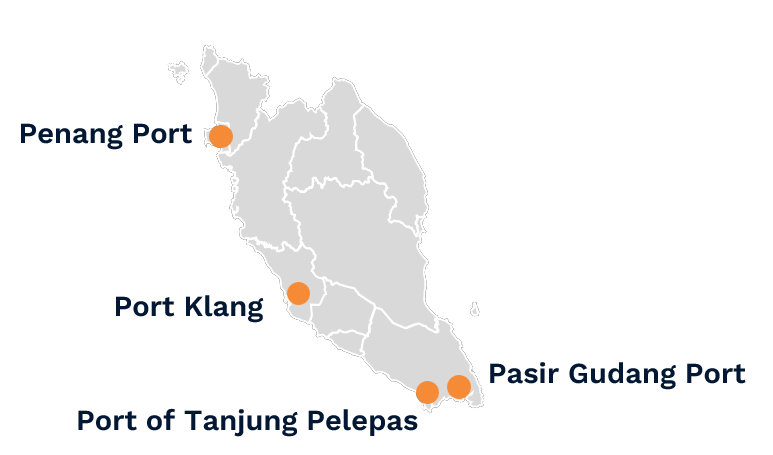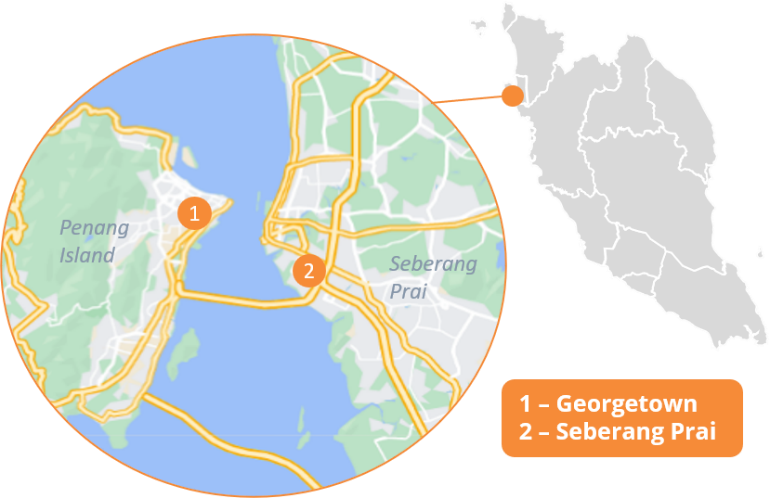Malaysia’s strategically located ports connect global shipping lanes in the Indian and Pacific Oceans. With efficient road, rail, and air links to Malaysia and beyond, these ports offer a cost-effective solution for global shippers. Read on and discover Malaysia’s key ports for shipping opportunities.

Ports of Penang
The Port of Penang is a major seaport located in the north of Malaysia. It is a deepwater port with terminals along the Penang Strait, including five in Seberang Perai and one in George Town. The port has the capacity to handle a throughput of 2 million TEUs annually. The port’s strategic location makes it a convenient gateway to the Northern region of Malaysia and Southern Thailand. It is also only 27 kilometers away from the Kulim Industrial Park in Kedah, where many manufacturing activities are located. This makes the port an important hub for trade and commerce in the region.

Ports Selangor
Port Klang is the largest port in Malaysia and one of the busiest ports in the world. It is located in the state of Selangor, on the Straits of Malacca, which is one of the busiest shipping lanes in the world. Port Klang handles a wide variety of cargo, including containers, bulk cargo, breakbulk cargo, and liquid cargo. It is also a major transhipment hub for the region, meaning that it handles cargo that is not destined for Malaysia, but is instead being transferred to other ports. In 2021, Port Klang handled a total of 13.7 million TEUs of containers. This makes it the second busiest port in Southeast Asia behind Singapore, and the 12th busiest port in the world.

Ports of Johor
The Port of Tanjung Pelepas (PTP) is a major container port located near the new mega port of Tuas in Singapore. In 2021, PTP handled a record 11 million TEUs of containers, a 14.3% increase from the previous year. This growth was driven by the global market rebound and spin-off impact post-Covid-19. PTP is planning to expand its infrastructure to accommodate the growing demand for container shipping. The port will be constructing a 455-meter additional berth north of the existing Berth 1, and will also be building 14 hectares of container yard. In addition, PTP has signed a contract to procure three additional STS cranes, which are expected to be fully operational by the end of 2023.
The Pasir Gudang Port (or Johor Port) is a major transshipment hub with a berth capacity of 1.45 million TEUs per annum. The port has a special railway station that connects to the national railway network and neighboring countries. It handles a variety of cargo, including bulk cargo, breakbulk cargo, liquid bulk cargo, and LCL (less than container load) shipments. The port has three berths with a total berthing length of 730 meters and a depth of 13.5 meters. It also has 9,600 square meters of CFS (container freight station) facilities for LCL cargo. The port offers a daily feeder service to Singapore.

Uniqueness of Malaysia
Overall, Malaysia’s ports have a number of unique features that make them stand out from other ports in Southeast Asia such as:
- Strategic location: Malaysia is located at the crossroads of major shipping lanes in the Indian Ocean and the Pacific Ocean. This gives its ports easy access to markets in Asia, Europe, and the Middle East.
- Deepwater ports: Malaysia’s ports are deepwater ports, which means that they can accommodate large ships. This makes them ideal for transshipment.
- Modern facilities: Malaysia’s ports have modern facilities, including container terminals, bulk terminals, and liquid terminals. This allows them to handle a wide variety of cargo.
Trusted Partner for Shipping to and from Malaysia
Malaysia is a hub for all industries due to its strategic location, skilled labor, as well as it’s logistics capability. However, it also important to work with a global freight forwarder with the local knowhow to help you overcome the challenges that may arise. Dimerco Malaysia has been serving their customers since its inception in 1984 with offices in Penang, Ipoh, Kuala Lumpur and Johor. Start a discussion with us and see how we can help you achieve your supply chain goals.